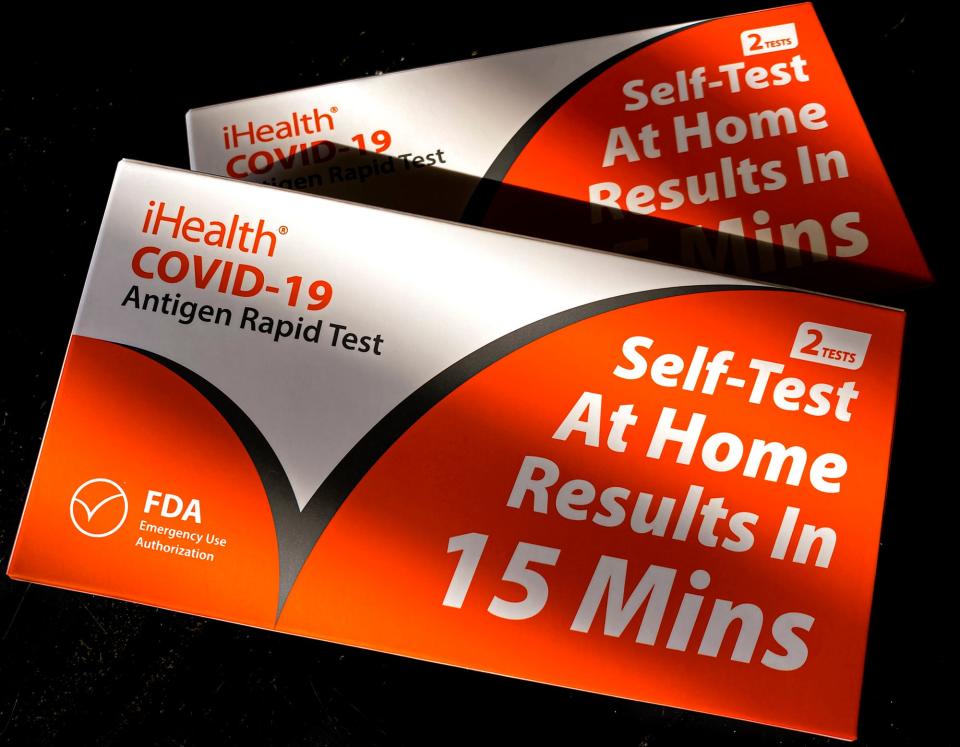As an even more contagious omicron subvariant spreads, Oklahoma's COVID-19 cases are rising
- Oops!Something went wrong.Please try again later.
COVID-19 is on the rise again in Oklahoma.
Last week, the state reported its largest weekly case total since February, according to state data.
And those numbers are almost certainly an undercount, since they don’t include at-home tests, which are being used more often lately. One Oklahoma expert suggested the true number of infections may be eight times higher than what's officially reported.
The increase is driven at least in part by a new omicron subvariant, dubbed BA.2.12.1, which is even more contagious than the original omicron variant or any other previous variants.
The subvariant has a mutation that makes it more adept at reinfecting people who had previously been infected with the original omicron variant, during the wave of infections in late 2021 and early 2022, said Dr. Dale Bratzler, chief COVID officer with the University of Oklahoma.

BA.2.12.1 now accounts for over half of the cases in our region, Bratzler said, citing data from the Centers for Disease Control and Prevention.
“It carries a mutation called the delta mutation,” he said. “People who got COVID in December, January in that huge omicron rush, their antibodies won't necessarily protect them against BA.2.12.1, because it has new mutations that the original omicron did not have. So we're seeing reinfections — people that have recovered from COVID in the past are retesting and being positive.”
COVID-19 in Oklahoma tracker: Weekly updates on new cases, deaths, vaccines
The latest COVID numbers
Oklahoma reported about 2,400 new cases in the state’s last weekly update Thursday, and the state reported more than 4,500 active cases.
Epidemiologist Aaron Wendelboe, who since the start of the pandemic has tracked COVID’s spread and used a model to project its outlook, said there are likely about eight times more infections in the community than there are cases being reported.
“I estimate in actuality, there were between 19,000 and 20,000 cases … in the state,” Wendelboe said on Tuesday’s Healthier Oklahoma Coalition call, referring to last week’s cases.
Underreporting of cases has increased throughout the pandemic, Wendelboe said. That’s due in part to an increasing use of at-home tests. As more people have gotten vaccinated, people infected might have mild enough symptoms that they don’t realize they have COVID-19 or don’t seek out a test, he said.
The state Health Department has acknowledged there are many more COVID-19 infections than cases being reported. Other metrics, including hospitalizations and deaths, still remain low as cases have risen, said Jan Fox, deputy commissioner for health preparedness with the state Health Department.
Across the state, there was an average of 109 people hospitalized with COVID-19, including 24 in the ICU, in the most recent data. That’s up from an average of 91 hospitalizations the previous week.
Hospitalizations are still well below the highs they reached during the omicron wave this year.
At Integris Health, staff have seen a small uptick in hospitalizations, but it hasn’t been overwhelming like in previous surges, said Dr. David Chansolme, medical director for infection prevention at Integris Health.
“But that's not the case, necessarily, everywhere in the country,” Chansolme said. “If you look back East, you know, they are seeing a big number of patients, and some hospitals even say it's more than any surge they've had. So we have to wait and see what happens.”
MORE: Can you still get long-haul COVID if you're vaccinated?
What to do if you test positive
If you test positive for COVID-19 on an at-home test, you may want to seek out a PCR test for confirmation, officials said.
On the other hand, if you test negative on an at-home test but still have symptoms you suspect could be COVID-19, it's still wise to seek out a PCR test, experts said.
PCR tests, which are considered the most sensitive and accurate tests available for COVID-19, also will be reported to the Health Department for official totals.
Fox, with the Health Department, said therapeutics and treatments for COVID-19 that were once in short supply are now more accessible. People who are interested in the treatments, which can help prevent hospitalizations or death from COVID-19, can contact their doctor, or if they don’t have a primary care provider, visit an urgent care, she said.
The Health Department has guidelines and a calculator for isolation and quarantine guidance on its website. In general, people should isolate for a minimum of five days after they test positive for COVID-19, and longer if they still have symptoms.
More: Over 5,800 deaths could've been avoided if all Oklahoma adults got a COVID-19 vaccine
Precautions to keep in mind
Experts urge Oklahomans to stay up to date on their COVID-19 vaccines.
“Staying current with your boosters can keep you out of the hospital and save your life,” said Wendelboe, the epidemiologist with the OU College of Public Health. “Especially if you're 50 years and older, you are eligible for a total of four doses.”
Immunocompromised people over age 12 are also eligible for a second booster dose.
The Health Department also urged wearing masks in public, following proper hand-washing techniques, and staying home when you’re sick.
To find a vaccine appointment near you, go to vaccines.gov or vaccinate.oklahoma.gov.
This article originally appeared on Oklahoman: Oklahoma's COVID cases rising: What to know about omicron subvariant

